-
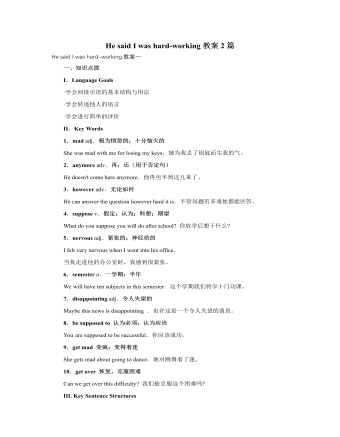
人教版新目标初中英语八年级下册He said I was hard-working教案2篇
This activity introduces some new vocabulary and provide oral practice using the target language.Task 1 . Ask four students to stand in front of the class, and the teacher asks them the following questions as a reporter.1.What are you going to do when you grow up?2.What are you going to do next week?3.What are going to do after school?The students will give different answers, then ask a good student to report what they said.I am going to e a doctor.What did she say?----------She said she was going to be a doctor.I am going to have a party on Friday night.What did he say?-------He said he was going to have a party on Friday night.I am going to do my homework.What did she say ?------ She said she was going to do her homework.I am going home after school.What did she say?-----She said she was going home after school.Say In this unit we are going to learn to use words like to report what someone said.Task 2. Read the instructions. Then ask a student to read the four questions. And write the words on the Bb. Explain what soap opera is.Task 3. Ask the students to Look at the pictures, point out the TV screens in the picture. Ask one girl to read what Marcia said.What did Marcia say? She said She said she was having a surprise party for Lana on Friday night. Repeat the other pictures in the same way.Activity3. Listen and number the pictures in activity 1a.
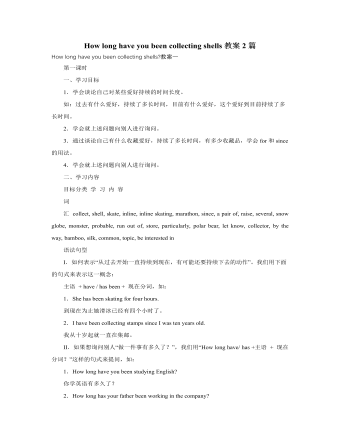
人教版新目标初中英语八年级下册How long have you been collecting shells教案2篇
Step Ⅱ Show the new words on the screen and teach the new words. Read the new words to students and ask them to repeat.Step Ⅲ 3aThis activity introduces new vocabulary and provides reading practice using the target language.In this activity first look at the four pictures.T: What can you see in the pictures?Ss: Four snow globes.T: Right. There are four snow globes in the pictures. And what are they?Ss: They are a monster, two polar bears, two penguins and a birthday cake.Write these words on the blackboard: snow globe; monster; polar bear; penguin and birthday cake. Read them to the class and ask students to repeat each one. Make sure students understand each word.Use a computer to show the E-mail message on the screen and read the message to students.Get students to read the e-mail on their own, and then draw lines connecting each snow globe and its description.Correct the answers.AnswersA line should connect each snow globe picture with the words that describe it in the letter.Step Ⅳ 3bThis activity provides writing practice using the target language.First review Activity 2a on Page 47.Then ask students to complete the message according to Activity 2a.Some partial sentences are given to students. Write about one person's collection.When students work, walk around the room checking the progress and offering help as needed.When they finish, ask some students to read their messages to the class.

人教版新目标初中英语八年级下册Why don’t you get her a scarf教案
教师带领学生复习有关描述宠物的词汇,采用教师提问学生回答的方进行。如:T:What animals do you think would be good pets?What animals do you think would be bad pets?What do you think are good animals for a six-year-old child?然后学生进行 pairwork 练习。Task two: 师生互动,学习探究 1、播放3a部分的录音,引导学生一边听录音,一边跟读。2、通过听录音学生回答以下问题:Why do you think pot-bellied pigs are popular?What are the advantages and disadvantages of keeping such a pet?教师对学生的回答进行及时点评。3.学习范文,学习重点短语,为下步的模仿写作提供语言素材。T :1. )Have you ever kept a pig as a pet?Do you like pigs? St.:No.…Why don’t you like to keep a pig? St: No.They’re too dirty and lazy(Do you know in some foreign countries like Hollyland, Australia,pigs are the most popular pet.there’s a kind of pig.(图)it has an interesting name? it ‘s called a pot-bellied pig.) Now,let’s learn an article about this kind of interesting pet.2.)play the tapeSt.:Listen and repeat3.)show some Qs on computer(本子St.: read silently,then answerthe Qs(本子)4.)Ask ss. Close book and retell this passage.(what is a pot-bellied pig? Is it a good or bad pet? ) St.: retell it to each other“A pot –bellied pig is a popular pet now…”5.read the article together.St.:.practice reading

人教版新目标初中英语八年级下册Would you mind turning down the music教案
Step 4. Group work (4)1. Ask a pair of students to read the dialogue. Say, This activity provides speaking, listening and writing practice using the target language.2. Ask students to complete the work in groups.3. Check the answers with the whole class. 4. Explain some of the language points. Step 5. Word review (Self check 1)1. Ask students to read the words and the phrases given. 2. Fill in the blanks with proper forms of these words to complete the sentences. 3. Check the answers with the whole class. Homework:Do activity 2 on page 57 after class. Period 6Teaching aims: 1. Teach vocabulary words and the useful expressions. 2. Enable the students to learn etiquette in different culture. 3. Help the students learn how to behave politely in public places and in daily life. Teaching procedures:Step 1. RevisionHelp students to review the function of making requests through a free talk. Then lead them to the topic of etiquette. Explain the meaning of etiquette. Or, ask students to look it up in the dictionary. Step 2. Pre-reading (Section 1)1. Ask students to read the picture and make a list with their partner about how many rules of etiquette can be seen being broken.
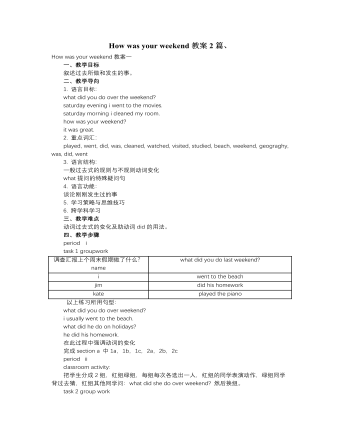
人教版新目标初中英语七年级下册How was your weekend教案2篇
Teaching Goal:1. General aims:Talk about recent past events2. Particular aims:A. Language Focus.Talk about recent past events and think of the past events.B. Language goalsHow was….?It was …What did …do over the weekend?C. Language structures:(1). How was your weekend? I was great. Pay attention to no form.(2). What did you do over the weekend? I played soccer. We went to the beach.D. Useful words and phrases:Words: was, did, went, beach, over, project, test, wasn’t, false, number, geography, spend, week, most, mixture, their, had, little, cook, read, saw, change, everyone, sit, sat, no, anythingPhrases: did one’s homework, played soccer, cleaned my room, went to the beach, played tennis, went to the movies, on Saturday morning, over the weekend, cook … for, what about, do some reading, have a party, talk show, go shoppingE. Grammar language:Present simple past tenseRegular and irregular verbsF. Learning strategies:Tour and holidaysG. Interdiscipinary:H. Emotion and manner:Teaching time: 5 periodsTeaching procedures:Period One教学步骤、时间 教师活动 学生活动 媒体应用Step 1Free talk 3’ Ask some questions like:Who’s on duty today?What’s the weather like? Answer and talk about something.让同学们回答下列问题1. Do you like weekend? (Let some students answer)It takes them three minutes to talk about the question.2. Why do you like weekend? (let the students answer) Most of the students like the weekend此时教师用汉语问:“在周末期间问你干了什么?这句话用英语这么回答?Let the students guess.At last the teacher give them right answer3. What did you do over the weekend?(板书、学习)
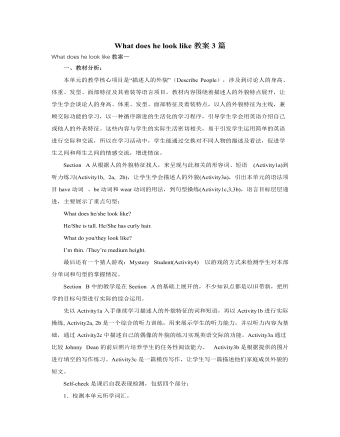
人教版新目标初中英语七年级下册What does he look like教案3篇
所需要用到的句子:Who is that?That is Jack. I like him.Why do you like him?I like him because he is interesting.Task 4: 设计理想中的人类Step one: 设计理想中的人类的外貌。把全班同学分成若干小组,学生可以边说边在纸上画出他们的模样。Step two: 设计理想中人类的性格。学生们可以把那些能描述性格的单词写在图画的旁边。Step three: 每组选出一名同学,其他同组同学提问,他作简单回答,并说明原因。所需用到的句子:What does he or she look like?He or she ...What is he or she like?He or she is ...Why?Because ...Task 5: 挑战性活动调查性格是天生的还是后天形成的,让每个同学回家去调查一下自己成长过程中性格是否有变化,具体是怎样的,为什么会这样? Teaching Aims:1. Enable students to have a general understanding of how to talk about people's physical appearance.2. Enable students to tackle some essential vocabularies and patterns about describing people. Provide them with necessary skills and methods.3. Create various chances for students to describe the persons they're familiar with, such as classmates, family members, teachers, idols, etc.
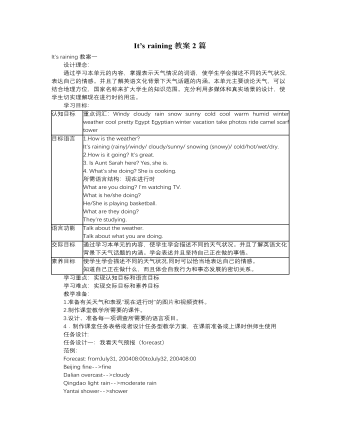
人教版新目标初中英语七年级下册It’s raining教案2篇
1 Each group choose one place to describe and what you are doing in it Choose one place, and describe what they are doing 2 Move around the room and give suggestions Talk about it and write it down 3 Ask one to show their works and act it Choose one of each group to make a report 4 Evaluate the best group and the best reporter Choose the best one Homework Ask your friends their ideal place and write about it教学反思:新课程标准中强调学生在课堂中的主体地位,在综合课中他们的主体地位就更加突出。在各个活动中给不同程度的学生不同层次的任务,让各层面的学生都有表现发挥的机会,从而产生对英语的兴趣。使用照片图片多媒体来辅助教学,效果更好。同时让了解其他国家风景,风俗的同学介绍ideal place,增加学生的背景知知识,实现跨学科交流的目的。教案点评:采用任务型教学模式,在各个活动中给不同程度的学生不同层次的任务,让各层面的学生都有表现发挥的机会,从而产生对英语的兴趣。使用照片图片多媒体来辅助教学,效果更好。让了解其他国家风景,风俗的同学介绍ideal place,增加学生的背景知识,实现跨学科交流的目的。

人教版新目标初中英语七年级下册Where is your pen pal from教案
2.1Match the country with the language.Step II Reading3a? let the students read the letter fast and answer the questions.? Let the students ask more questions about the letter as possible as the can.Step III Writing3b.Step IV. Pairwork2cStep V Listening2a, 2bStep V. HomeworkExercises book(1) P3Exercises book (2) P3Period FourStep I . Dictate the words and sentences in Unit1.Step II. Self-checkStep III. Check the answers for Exercises book in the unit.Step IV. Home workRevise and preparation for unit 2.教学反思:通过本单元的学习,学生基本可以谈论人们的国籍,居住城市及其所说的语言,通过书信方式去介绍自己并寻找笔友。但在涉及到国外的一些城市时,学生对这方面的知识相对欠缺,能介绍的城市并不多,也反应出学生课前预习不充分,这跟学生学习条件也有关,大多数学生无法通过网络获取所需信息。因此,在以后的教学中要多指导学生通过计算机网络获取信息,拓宽知识面。

人教版新目标初中英语七年级下册Where did you go on vacation教案
句型: Where did you go on vacation? I went to summer camp.Did she go to Central Park?Yes,she did.No, she didn’t语法:一般过去时特殊疑问句、一般疑问句及肯、否定回答。课时安排4课时第一课时:Section A:la,1b,lc,2a,2b,2c 第二课时:Section A:3a,3b,4第三课时:Section B:1,2a,2b,2c第四课时:Section B:3a,3b,3c,4 and Self Check第一课时教学目标掌握描写假期生活的形容词。假期里自己所做事情的简单表达。谈论假期做的事情及当时情况。谈论假期时旅游的天气,旅游者以及食物等。教学过程一、导入播放一首英文歌曲:Let’s travel 说明:通过让学生听节奏欢快迪斯尼英语歌曲Let’s travel.引入本节课谈论的话题vacation and travel. 让歌曲使学生的思维活跃,增强课堂气氛,激发学生提高学习英语的兴趣。T:How is the trip ?Ss : It’s pretty good/ happy/exciting /relaxing/busy/dangerous/ fantastic说明:这个问题是为了操练形容词。建议让多个Ss作答。鼓励他们用不同的形容词。上述个别形容词本应在第二课时中出现,但可以在warming-up中第一次非正式出现。这些形容词也可在老师的评价语中适时出现,以加深学生对词汇的印象。
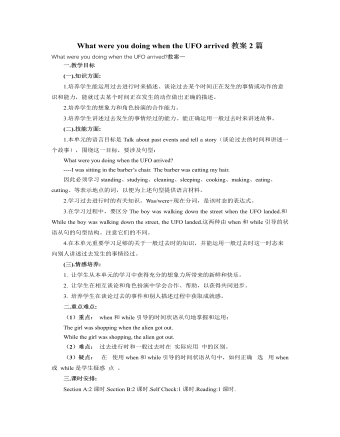
人教版新目标初中英语八年级下册What were you doing when the UFO arrived教案2篇
(一).知识方面: 1.培养学生能运用过去进行时来描述、谈论过去某个时间正在发生的事情或动作的意识和能力,能就过去某个时间正在发生的动作做出正确的描述。 2.培养学生的想象力和角色扮演的合作能力。 3.培养学生讲述过去发生的事情经过的能力。能正确运用一般过去时来讲述故事。 (二).技能方面: 1.本单元的语言目标是Talk about past events and tell a story(谈论过去的时间和讲述一个故事),围绕这一目标,要涉及句型: What were you doing when the UFO arrived? ----I was sitting in the barber’s chair. The barber was cutting my hair. 因此必须学习standing、studying、cleaning、sleeping、cooking、making、eating、cutting、等表示地点的词,以便为上述句型提供语言材料。2.学习过去进行时的有关知识。Was/were+现在分词,是该时态的表达式。 3.在学习过程中,要区分The boy was walking down the street when the UFO landed.和While the boy was walking down the street, the UFO landed.这两种由when和while引导的状语从句的句型结构。注意它们的不同。
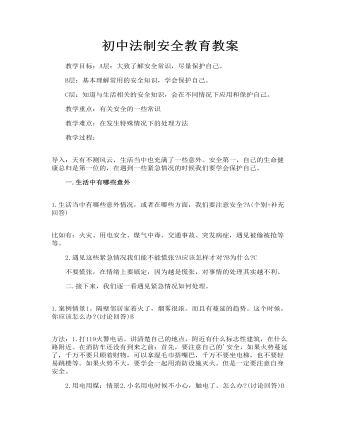
初中法制安全教育教案
一.生活中有哪些意外 1.生活当中有哪些意外情况,或者在哪些方面,我们要注意安全?A(个别+补充回答) 比如有:火灾、用电安全、煤气中毒、交通事故、突发病症,遇见被偷被抢等等。 2.遇见这些紧急情况我们能不能慌张?A应该怎样才对?B为什么?C 不要慌张,在情绪上要镇定,因为越是慌张,对事情的处理其实越不利。
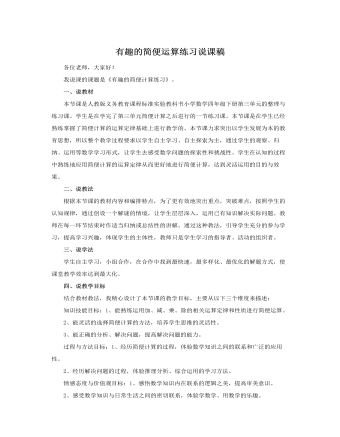
人教版新课标小学数学四年级下册有趣的简便运算练习说课稿
学生自己讨论如何比较两道算式的大小,根据时间进行调节,若有时间进行讲解,若无时间留作回家思考的题目。课件在这一环节充分利用了声音,图像等手段,让学生对嘟嘟熊这一朋友有了直观的认识,嘟嘟熊的出现,使本节课又推向了一个新的高潮。这时恰当进行全课总结,颁发礼物的同时又进行了德育渗透,使整节课水到渠成。整节课在教学环节上由一条嘟嘟熊的线索贯穿到底,很自然,顺畅。从基本练习——对比练习——计算练习——巧算总分——比一比,由简到难,而且在每个环节中也都有层次,形成了一个立体的,多维的课堂。在教学中教师始终秉承一个理念:“不同的人在数学上得到不同的发展”。使得这节课在很多环节都体现了算法多样化及合作学习。在教学评价上,本节课很重视师生评价,生生互评,而且评价的方式也多样化,有口头表扬,有贴纸奖励,更有最后的全班评价奖励,可以说整节课都将德育渗透进行到底!
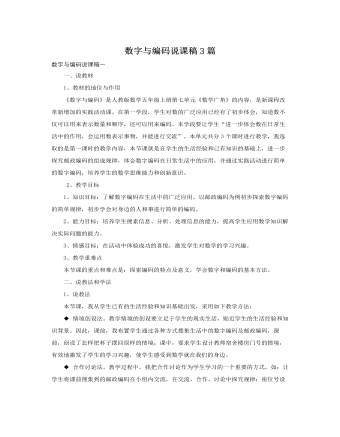
人教版新课标小学数学五年级上册数字与编码说课稿3篇
[设计意图:根据数学来源于生活的新课程理念,课前让学生回家搜集,课中让学生交流,与全班同学资源共享,在此基础上观察身份证上的内容,激发了学生参与学习的积极性。]3、讨论,探索规律。⑴合作讨论。①你们手中的身份证号码有什么相同点和不同点?②谁能介绍一下自已身份证上这些数字号码表示的意义? ⑵学生汇报。学生介绍发现的信息以及它们的含义。[设计意图:这是本节课的重点,为了引导学生探索身份证号码的编排规律,把学生分成4人小组,要求学生利用自己收集到的身份证号码、教材等学习资源,采取观察、比较、猜测等方法,探索身份证号码的编码规律,然后在全班交流学习成果,反馈学习情况,让学生初步了解身份证号码的编排特点。]
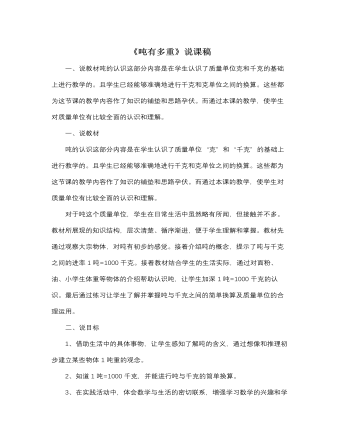
北师大版小学数学三年级下册《吨有多重》说课稿
一、说教材吨的认识这部分内容是在学生认识了质量单位“克”和“千克”的基础上进行教学的。且学生已经能够准确地进行千克和克单位之间的换算。这些都为这节课的教学内容作了知识的铺垫和思路孕伏。而通过本课的教学,使学生对质量单位有比较全面的认识和理解。对于吨这个质量单位,学生在日常生活中虽然略有所闻,但接触并不多。教材所展现的知识结构,层次清楚、循序渐进,便于学生理解和掌握。教材先通过观察大宗物体,对吨有初步的感觉。接着介绍吨的概念,提示了吨与千克之间的进率1吨=1000千克。接着教材结合学生的生活实际,通过对面粉、油、小学生体重等物体的介绍帮助认识吨,让学生加深1吨=1000千克的认识。最后通过练习让学生了解并掌握吨与千克之间的简单换算及质量单位的合理运用。
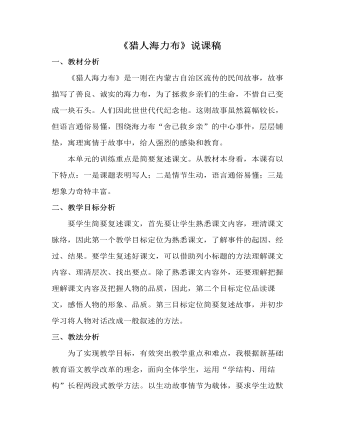
部编人教版五年级上册《猎人海力布》说课稿
一、教材分析《猎人海力布》是一则在内蒙古自治区流传的民间故事,故事描写了善良、诚实的海力布,为了拯救乡亲们的生命,不惜自己变成一块石头。人们因此世世代代纪念他。这则故事虽然篇幅较长,但语言通俗易懂,围绕海力布“舍己救乡亲”的中心事件,层层铺垫,寓理寓情于故事中,给人强烈的感染和教育。本单元的训练重点是简要复述课文。从教材本身看,本课有以下特点:一是课题表明写人;二是情节生动,语言通俗易懂;三是想象力奇特丰富。二、教学目标分析要学生简要复述课文,首先要让学生熟悉课文内容,理清课文脉络,因此第一个教学目标定位为熟悉课文,了解事件的起因、经过、结果。要学生复述好课文,可以借助列小标题的方法理解课文内容、理清层次、找出要点。除了熟悉课文内容外,还要理解把握理解课文内容及把握人物的品质,因此,第二个目标定位品读课文,感悟人物的形象、品质。第三目标定位简要复述故事,并初步学习将人物对话改成一般叙述的方法。
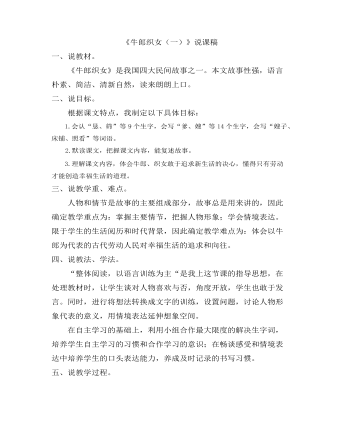
部编人教版五年级上册《牛郎织女(一)》 说课稿
三、说教学重、难点。人物和情节是故事的主要组成部分,故事总是用来讲的,因此确定教学重点为:掌握主要情节,把握人物形象;学会情境表达。限于学生的生活阅历和时代背景,因此确定教学难点为:体会以牛郎为代表的古代劳动人民对幸福生活的追求和向往。四、说教法、学法。“整体阅读,以语言训练为主“是我上这节课的指导思想,在处理教材时,让学生谈对人物喜欢与否,角度开放,学生也敢于发言。同时,进行将想法转换成文字的训练,设置问题,讨论人物形象代表的意义,用情境表达延伸想象空间。
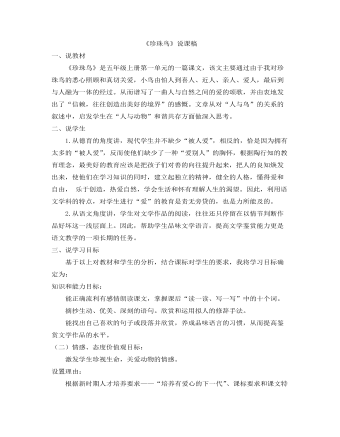
部编人教版五年级上册《 珍珠鸟》说课稿
二、说学生 1.从德育的角度讲,现代学生并不缺少“被人爱”,相反的,恰是因为拥有太多的“被人爱”,反而使他们缺少了一种“爱别人”的胸怀,根据陶行知的教育理念,最美好的教育应该是把孩子们对善的向往提升起来,把人的良知焕发出来,使他们在学习知识的同时,建立起独立的精神,健全的人格,懂得爱和自由, 乐于创造,热爱自然,学会生活和怀有理解人生的渴望。因此,利用语文学科的特点,对学生进行“爱”的教育是责无旁贷的,也是力所能及的。2.从语文角度讲,学生对文学作品的阅读,往往还只停留在以情节判断作品好坏这一浅层面上。因此,帮助学生品味文学语言,提高文学鉴赏能力更是语文教学的一项长期的任务。
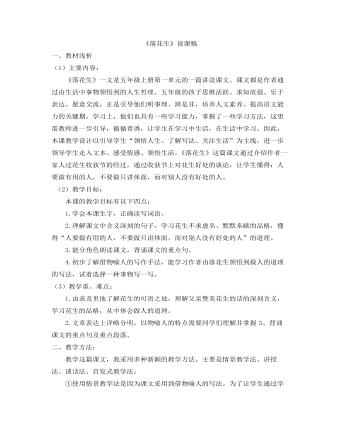
部编人教版五年级上册《 落花生》说课稿
(1)主要内容:《落花生》一文是五年级上册第一单元的一篇讲读课文。课文都是作者通过由生活中事物领悟到的人生哲理。五年级的孩子思维活跃、求知欲强、乐于表达、愿意交流,正是引导他们明事理、辨是非,培养人文素养、提高语文能力的关键期。学习上,他们也具有一些学习能力,掌握了一些学习方法,这更需教师进一步引导,循循善诱,让学生在学习中生活,在生活中学习。因此,本课教学设计以引导学生“领悟人生、了解写法、关注生活”为主线,进一步领导学生走入文本、感受情感、领悟生活。《落花生》这篇课文通过介绍作者一家人过花生收获节的经过,通过收获节上对花生好处的谈论,让学生懂得:人要做有用的人,不要做只讲体面,而对别人没有好处的人。(2)教学目标:本课的教学目标有以下四点:1.学会本课生字,正确读写词语。
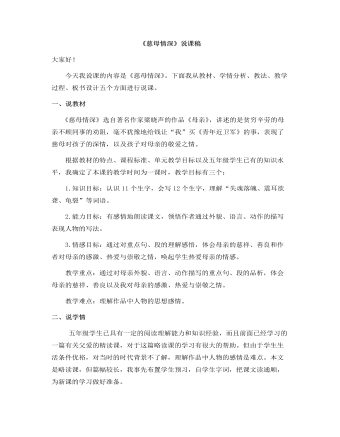
部编人教版五年级上册《慈母情深》说课稿
大家好!今天我说课的内容是《慈母情深》。下面我从教材、学情分析、教法、教学过程、板书设计五个方面进行说课。一、说教材《慈母情深》选自著名作家梁晓声的作品《母亲》,讲述的是贫穷辛劳的母亲不顾同事的劝阻,毫不犹豫地给钱让“我”买《青年近卫军》的事,表现了慈母对孩子的深情,以及孩子对母亲的敬爱之情。根据教材的特点、课程标准、单元教学目标以及五年级学生已有的知识水平,我确定了本课的教学时间为一课时,教学目标有三个:1.知识目标:认识11个生字,会写12个生字,理解“失魂落魄、震耳欲聋、龟裂”等词语。
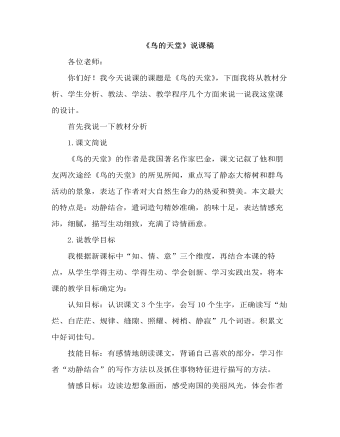
部编人教版五年级上册《鸟的天堂》说课稿
二、学生分析五年级是小学生知识、能力、情感价值观形成的关键时期,他们对自我、他人、家庭、社会有了一些浅显的认识,养成了一定的好的学习习惯,有了一定的阅读能力,读书提问的能力。因本课的阅读性、活动性、实践性较强,绝大部分学生对于如何在阅读活动中边读边想的方法不明确,在实践中应怎想,想什么不够明晰。下面为了讲清重点、难点,使学生能达到本节设定的教学目标,我再从教法和学法上谈谈。三、说教法在教学中,我们不仅要让学生“知其然”而且要让学生“知其所以然”,科学合理的教学方法,能使教学效果事半功倍,达到教与学的和谐完美统一。为了达到目标,突出重点,突破难点,解决疑难,我具体运用了以下几种教法,情景设置法——主要是激发学生情感,引起他们的学习兴趣,讲授法——充分发挥教师的主导作用,系统地向学生传授知识。点拨法——是教师在学生讨论的过程中,伺机点拨,让他们展开联想和想象,拓展思路。在以上几种教法中点拨法是最重要的一种方法。

